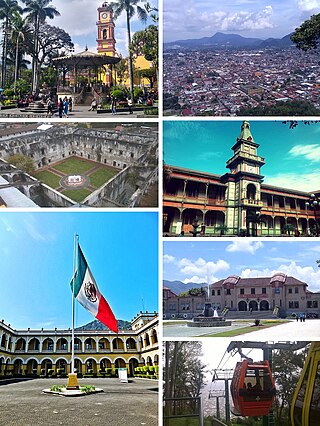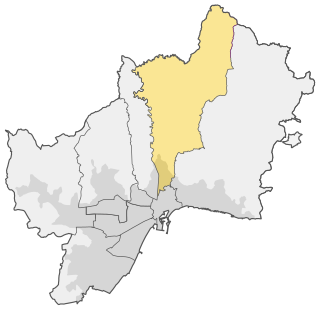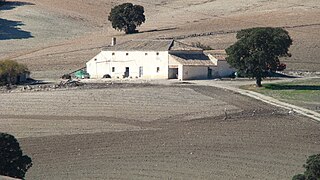
Xalapa or Jalapa, officially Xalapa-Enríquez, is the capital city of the Mexican state of Veracruz and the name of the surrounding municipality. In the 2020 census the city reported a population of 443,063 and the municipality of which it serves as municipal seat reported a population of 488,531. The municipality has an area of 118.45 km2. Xalapa lies near the geographic center of the state and is the second-largest city in the state after the city of Veracruz to the southeast.

Málaga is a municipality of Spain, capital of the Province of Málaga, in the autonomous community of Andalusia. With a population of 578,460 in 2020, it is the second-most populous city in Andalusia and the sixth most populous in the country. It lies in Southern Iberia on the Costa del Sol of the Mediterranean, primarily in the left bank of the Guadalhorce. The urban core originally developed in the space between the Gibralfaro Hill and the Guadalmedina.

Orizaba is a city and municipality in the Mexican state of Veracruz. It is located 20 km west of its sister city Córdoba, and is adjacent to Río Blanco and Ixtaczoquitlán, on Federal Highways 180 and 190. The city had a 2020 census population of 120,500 and is almost coextensive with its small municipality, with only a few small areas outside the city. The municipality, with an area of 27.97 km2, had a population of 123,182. While the metropolitan area of Orizaba has a population of 462,261 as 2020.
Carlos Thays was a French-Argentine landscape architect, and a student of French landscape architect Édouard André.

Real Jardín Botánico de Madrid is an 8 hectares botanical garden in Madrid (Spain). The public entrance is located at Plaza de Murillo, next to the Prado Museum.
Serranía de la Macarena is an isolated mountain range located in the Meta Department, Colombia. It was named after the Virgin of Hope of Macarena. The mountains are separated by about 40 km (25 mi) at their northern extreme from the East Andes. The range is orientated from north to south and is 120 km (75 mi) in length and 30 km (19 mi) wide. The highest peak reaches 2,615 m (8,579 ft) and is the highest point of the Orinoquía Region. The first national reserve in Colombia was established in the central part of the mountain range in accordance with a Congressional Law promulgated in 1948. The status of National Natural Park was designated in 1971 and the protected area encompasses 6,200 km2 (2,400 sq mi).

The Naguanagua municipality is one of the 14 municipalities (municipios) that makes up the Venezuelan state of Carabobo and, according to the 2011 census by the National Institute of Statistics of Venezuela, the municipality has a population of 157,437. The town of Naguanagua is the shire town of the Naguanagua Municipality. It forms part of the greater Valencia Metropolitan Area in Venezuela. It is in the valley of the Cabriales River at the base of Cerro El Café and the El Trigal Mountain. Valencia and Naguanagua form a continuous urban area. The highway that runs from the centre of Valencia towards Puerto Cabello passes through this community; Bolivar Avenue in Valencia becomes University Avenue in Naguanagua on the northern side of a traffic roundabout, or redoma.

Centro, also known as District 1 and Málaga-Centro, is one of the 11 districts of the city of Málaga, Spain.

Ciudad Jardín, also known as District 3, is one of the 11 districts of the city of Málaga, Spain.

A cortijo is a type of traditional rural dwelling in the southern half of Spain, including all of Andalusia and parts of Extremadura and Castile-La Mancha.
The following is a timeline of the history of the city of Holguín, Cuba.

The Naguanagua Botanical Garden, also known as Bachiller José Saer D'Eguert Botanical Garden, is a botanical garden located south of the city of Naguanagua, Carabobo State in the South American country of Venezuela. It has a free area of about 15 hectares, with more than 200 adult trees.

Amalia Herédia Livermore was a Spanish patron, collector, researcher, and philanthropist, as well as a promoter of arts and culture.

The Jardín Botánico Histórico La Concepción is an landscape garden with over one hundred and fifty years of history. It is located at the northern entrance of the Spanish city of Málaga. This garden is one of the few gardens with subtropical plants that exist in Europe. It has more than fifty thousand plants, of two thousand species of tropical, subtropical, and autochthonous, highlighting the collection with more than one hundred different species of palms, bamboos, aquatic plants and its historical garden.